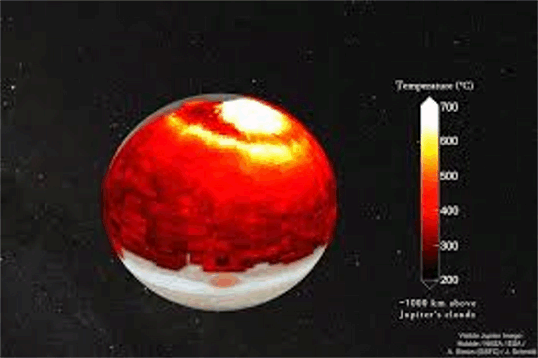주제: 행성과 소행성
4월 4일 금요일
목성 북극의 오로라.
태양풍은 과학자들이 이전에 생각했던 것보다 목성의 오로라를 증폭하는 데 더 큰 역할을 할 수 있습니다. (제공: NASA, ESA, J. Nichols(University of Leicester) A. Simon NASA 및 OPAL 팀.)
간단히 말해서:
지구 여러 개 크기의 고온대가 목성에서 처음으로 포착되었습니다.
과학자들은 이 열이 태양풍이 자기장을 압축했기 때문이라고 믿고 있으며, 이는 한 달에 여러 번 발생할 수 있습니다.
다음은 무엇일까요?
이 현상은 목성의 남반구에서도 발생할 수 있으며, 추가 연구를 통해 태양풍이 행성의 날씨에 얼마나 많은 영향을 미치는지 확인할 수 있습니다.
목성의 놀라운 오로라는 보이저 1호가 거의 50년 전에 지나간 이후로 많은 망원경과 우주선에 의해 포착되었습니다.
과학자들은 최근 행성의 반쯤을 둘러싼 신비한 뜨거운 가스 띠를 발견했습니다. 알루미늄을 녹일 만큼 뜨거운 가스 띠입니다.
레딩 대학교의 행성 과학자 제임스 오도노휴는 가스 띠가 주변보다 수백 도 더 따뜻하다고 말했습니다.
그는 “거대 행성에서 이런 것을 본 것은 처음입니다.”라고 말했습니다.
핫스팟의 원인은 알려지지 않았지만 오도노휴 박사와 동료들이 NASA의 주노 우주선에서 얻은 데이터를 새롭게 분석한 결과 답이 나올 수 있습니다.
그들의 연구에 따르면 목성은 태양에서 온 거대한 입자파에 맞아 행성의 자기 방패에 부딪혔습니다.
이로 인해 온도가 급등하는 강렬한 오로라 폭발이 발생했습니다.
더 높은 온도의 넓은 띠를 보여주는 목성 지도.
목성의 열 지도는 섭씨 500도가 넘는 거대한 가스 띠를 보여주었습니다. (제공: 레딩 대학교 제임스 오도노휴 박사)
오늘 Geophysical Research Letters에 발표된 이 연구는 태양의 입자(일명 “태양풍”)가 목성과 다른 행성의 오로라를 어떻게 증폭시키는지에 대한 과학자들의 이해를 뒤집을 수 있습니다.
“[목성과 같은] 외행성에는 오랫동안 내부적으로 구동되는 것으로 여겨져 온 고유한 오로라가 있습니다.” 오도노휴 박사가 말했습니다.
“하지만 점점 더 발견되는 것은 태양풍이 오로라 활동을 증폭시키는 데 엄청난 영향을 미칠 수 있다는 것입니다.”
신비한 핫스팟
2017년 1월 말, 하와이의 케크 망원경은 그전처럼 목성을 향해 조준했고, 특이한 것을 발견했습니다.
이 망원경은 수소 유형을 측정하여 거기에 있어서는 안 될 거대한 열 띠를 포착했습니다.
목성의 배경 온도는 보통 섭씨 350도 정도이지만, 가열된 가스 띠는 500도 이상이었습니다.
“지구상에서 가장 큰 망원경 중 하나를 사용하여 목성의 상층 대기에서 예상치 못하게 높은 온도가 있는 광대하고 행성 규모의 영역을 발견했습니다.”라고 오도노휴 박사는 말했습니다.
“이 열은 보통 높은 온도가 예상되는 극지방 오로라와는 거리가 멉니다.”
태양계 전체의 오로라는 대전된 입자가 자기권(많은 행성이 가지고 있는 행성 전체의 방패)과 상층 대기와 상호 작용하여 생성되며, 이로 인해 놀라울 정도로 많은 열이 증가할 수 있습니다.
“많이 사용된 전선은 전류가 흐르기 때문에 만지면 따뜻해지고, 행성의 상층 대기도 마찬가지입니다.”라고 오도노휴 박사는 말했습니다.
지구의 오로라는 태양의 태양풍이 지구 자기권으로 대전된 입자를 흐르게 하여 극지방으로 이동하여 대기의 다양한 가스를 자극하여 발생합니다.
하지만 목성, 토성, 천왕성, 해왕성과 같은 외행성의 영구 오로라는 태양의 영향을 받지 않는 것으로 여겨졌습니다.
목성의 경우 오로라는 인근 위성인 이오의 거대한 화산에서 뿜어져 나오는 산소와 황 입자가 목성의 자기장과 상호 작용하여 부분적으로 발생합니다.
비디오 길이: 42초.
42초 동안 시청
큰 가열된 띠는 여러 지구 크기입니다.
2021년 오도노휴 박사와 그의 팀은 극지방에서 멀리 떨어진 이 열띠의 원인이 오로라일 수 있다는 연구를 발표했지만 전체적인 그림은 없었습니다.
“2017년 관측 결과 목성의 오로라가 행성을 가열할 수 있다는 것이 밝혀졌지만 이 특정 고온 특징의 원인은 불분명했습니다.”라고 그는 말했습니다.
“우리는 그것이 태양풍 때문일 수 있다는 것을 확실히 확인하기 위해 더 많은 증거가 필요했습니다.”
운 좋은 우주선
케크 관측과 같은 날, NASA의 주노 우주선은 우연히 가스 행성을 네 번째로 통과하여 목성 북반구의 구름에서 5,000km 떨어진 곳까지 접근했습니다.
주노가 수집한 데이터에 따르면 우주선이 통과할 때 목성의 자기권이 압축되고 있었습니다.
태양 플레어의 나란히 배치된 이미지
2024년 5월의 이러한 태양 플레어는 태양풍 폭발과 관련이 있습니다. (제공: NASA/SDO)
“N의 새로운 데이터를 결합하여
ASA의 주노 임무, 새로운 태양풍 모델링, 그리고 이 특징의 속도를 측정하는 새로운 방법을 통해, 우리는 몇 시간 전에 주요 태양풍 사건이 발생했고, 그것이 유력한 트리거가 되었다는 것을 발견했습니다.” 오도노휴 박사는 말했습니다.
이 아이디어는 태양풍이 목성에 부딪혔을 때 자기장이 압축되어 극지방에서 극심한 오로라 활동과 열을 발생시켰다는 것입니다.
오도노휴 박사에 따르면, 과열된 가스가 “거대한 파도처럼” 적도 쪽으로 남쪽으로 흘러나왔습니다.
퀸즐랜드 남부 대학교의 천문학자이자 목성 오로라 전문가인 루시나 케지오라-추드처에 따르면, 태양풍에 대한 설명은 현재 가능한 가장 좋은 설명입니다.
“이 논문은 지상에서의 관측이 우주에서의 관측을 어떻게 보완할 수 있는지 보여주는 좋은 예입니다.”라고 그녀는 말했습니다.
“이것이 처음으로 목격되었기 때문에 매우 흥미롭습니다.”
소용돌이가 있는 목성의 아름다운 사진 구름과 이미지 상단의 붉은 반점.
주노는 목성을 수십 번이나 플라이바이했고, 계획된 은퇴 후에도 여전히 활동 중입니다. (NASA: JPL-Caltech/SwRI/MSSS/Gerald Eichstad/Sean Doran/CC NC SA)
연구원들은 이 현상이 한 달에 여러 번 발생할 수 있다고 믿고 있으며, 지구 기반 망원경을 사용하여 이를 포착할 수 있는 기회가 훨씬 더 많을 것이라고 제안합니다.
“지금까지 우리는 목성의 북반구에서만 이 특징을 보았지만, 남부 오로라에서 멀어지는 유사한 열파가 남부에 대응할 것입니다.” 오도노휴 박사가 말했습니다.
“향후 작업은 두 반구에서 이러한 이벤트를 더 많이 추적하고 이동 속도를 측정하는 데 중점을 둘 것입니다.
“이를 통해 목성의 지구 바람 순환을 매핑하고 태양풍이 상층 대기 날씨에 얼마나 많은 영향을 미치는지 이해하는 데 도움이 될 것입니다.”
받은 편지함으로 과학
ABC 전역의 모든 최신 과학 스토리를 받아보세요.
귀하의 정보는 ABC 개인정보 수집 정책에 따라 처리됩니다.
이 사이트는 reCAPTCHA에 의해 보호되며 Google 개인정보 처리방침과 서비스 약관이 적용됩니다.
이메일 주소
ozilbo07@gmail.com
구독
2025년 4월 4일 금요일 오전 6시에 게시됨2025년 4월 4일 금요일 오전 6시에 게시됨, 2025년 4월 4일 금요일 오전 6시 35분에 업데이트됨2025년 4월 4일 금요일 오전 6시 35분
Jupiter’s mysterious hotspot created by solar wind: study
By science reporter Jacinta Bowler
Fri 4 AprFriday 4 April
In short:
A high temperature band the size of multiple Earths has been captured on Jupiter for the first time.
Scientists believe the heat was due to solar winds squeezing the magnetic field, and this may happen multiple times a month.
What’s next?
This phenomenon may also occur on the southern hemisphere of Jupiter, and more research can determine how much influence the solar wind has on the planet’s weather.
abc.net.au/news/solar-wind-jupiter-aurora-heat/105121366
Link copiedShare article
Jupiter’s stunning auroras have been captured by many telescopes and spacecraft since Voyager 1 flew by nearly 50 years ago.
Recently, scientists detected a mysterious band of hot gas — almost hot enough to melt aluminium — that stretched halfway around the planet.
The band of gas was hundreds of degrees warmer than its surroundings, said James O’Donoghue, a planetary scientist at the University of Reading.
“It’s the first time we’ve ever seen anything like this on a giant planet,”
he said.
It was unknown what caused the hotspot, but a new analysis of data from NASA’s Juno spacecraft by Dr O’Donoghue and colleagues may hold the answer.
Their research suggests Jupiter was hit by a massive wave of particles from the Sun slamming into the planet’s magnetic shield.
This in turn produced an intense auroral burst that sent temperatures soaring.
The research, published today in Geophysical Research Letters, may up-end scientists’ understanding of how particles from the Sun — aka “solar wind” — boost auroras on Jupiter and other planets.
“The outer planets [like Jupiter] have their own auroras which have long been thought to be highly internally-driven,” Dr O’Donoghue said.
“But what we’re increasingly finding is that the solar wind can have a massive effect on boosting auroral activity.”
A mysterious hotspot
In late January 2017, the Keck Telescope in Hawaii pointed its sights towards Jupiter, like it has many times before, and found something unusual.
Using a measurement of a type of hydrogen, the telescope captured a large band of heat which wasn’t supposed to be there.
While the background temperature of Jupiter is usually around 350 degrees Celsius, the band of heated gas was more than 500 degrees.
“Using one of the largest telescopes on Earth, we found a vast, planetary-scale region of unexpectedly high temperatures in Jupiter’s upper atmosphere,” Dr O’Donoghue said.
“This heat is located far from the polar auroras, where we usually expect high temperatures.”
Auroras throughout the solar system are produced by charged particles interacting with the magnetosphere — a planet-wide shield many planets have — and the upper atmosphere, which can cause a surprisingly large increase in heat.
“Heavily used electric cables get warm to the touch because a current runs through them, and the upper atmosphere of a planet does the same,” Dr O’Donoghue said.
Earth’s auroras are caused by the Sun’s solar winds streaming charged particles down on Earth’s magnetosphere that travel towards the poles where they excite different gases in the atmosphere.
But it was thought the permanent auroras on the outer planets like Jupiter, Saturn, Uranus and Neptune weren’t affected by the Sun.
In Jupiter’s case, the aurora is partially caused by oxygen and sulphur particles spewing out from giant volcanoes on its nearby moon, Io, which then interact with Jupiter’s magnetic field.
In 2021, Dr O’Donoghue and his team published a study that suggested auroras could be the cause of this band of heat away from the poles, but they didn’t have the full picture.
“The 2017 observations had shown that Jupiter’s auroras could heat the planet, but the cause of this specific hot feature was unclear” he said.
“We needed more evidence to confidently confirm it could be due to the solar wind.”
A lucky spacecraft
On the same day as the Keck observation, NASA’s Juno spacecraft just happened to be undertaking its fourth flyby of the gas giant, coming within 5,000 kilometres of Jupiter’s clouds on the northern hemisphere of the planet.
Data captured by Juno revealed Jupiter’s magnetosphere was being compressed when the spacecraft went through it.
“By combining new data from NASA’s Juno mission, new solar wind modelling, and new methods to measure the feature’s speed, we found that a major solar wind event occurred just hours earlier, making it the likely trigger,” Dr O’Donoghue said.
The idea is that when the solar winds slammed into Jupiter they squashed the magnetic field, which produced extreme auroral activity and heat at the poles.
According to Dr O’Donoghue, superheated gas spilled south towards the equator “like a giant wave”.
According to Lucyna Kedziora-Chudczer, an astronomer at the University of Southern Queensland and expert in Jupiter’s aurora, the solar wind explanation is the best currently available.
“This paper is a great example of showing how observation from the ground can complement observations from space,” she said.
“It’s quite exciting because this is the first time it’s been seen.”
The researchers believe this phenomenon could occur multiple times a month, and suggest there might be plenty more opportunities to catch it using Earth-based telescopes.
“So far, we’ve only seen this feature in Jupiter’s northern hemisphere — but there should be a southern counterpart: a similar wave of heating moving away from the southern aurora,” Dr O’Donoghue said.
“Future work will focus on tracking down more of these events in both hemispheres and measuring how fast they travel.
“This will help us to map Jupiter’s global wind circulation and understand just how much influence the solar wind has on upper-atmospheric weather.”
Science in your inbox
Get all the latest science stories from across the ABC.
Your information is being handled in accordance with the ABC Privacy Collection Statement.
This site is protected by reCAPTCHA and the Google Privacy Policy and Terms of Service apply.
https://www.google.com/recaptcha/api2/anchor?ar=1&k=6LcNjL8lAAAAAB3chG8dvYH2LKi33r9xFw0kihjQ&co=aHR0cHM6Ly93d3cuYWJjLm5ldC5hdTo0NDM.&hl=ko&type=image&v=hbAq-YhJxOnlU-7cpgBoAJHb&theme=light&size=invisible&badge=bottomright&cb=d7amhvvqi11vEmail addressSubscribe
Posted Fri 4 Apr 2025 at 6:00amFriday 4 Apr 2025 at 6:00am, updated Fri 4 Apr 2025 at 6:35amFriday 4 Apr 2025 at 6:35am











답글 남기기
댓글을 달기 위해서는 로그인해야합니다.